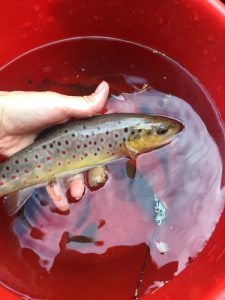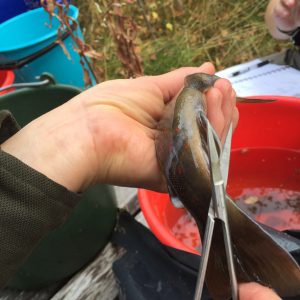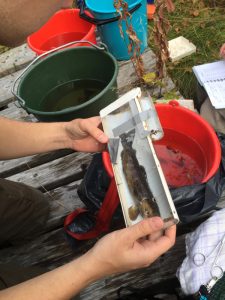 One of our captured (but soon released) Brown trout. Photo: Johanna Hägglund
One of our captured (but soon released) Brown trout. Photo: Johanna Hägglund
Turns out winter has decided to turn around at the doorstep – today I was met at the door by cold gusts of freezing rain settling down on the slush that remains of the snowfall we’ve had. So I thought it’d be the perfect day to look back at the mini-course in electrofishing we had during the Census techniques course earlier during autumn!
Everything was set up as a part of the county administration boards continuous monitoring program, where they look at salmonids in Ume River as part of ongoing restoration and conservation work to see how alternative routes around the hydropower plant are functioning!
In this massive project, they use very many different techniques for counting fish, but for small tributaries it’s effective to electrofish – basically, you attract fish with an electrified rod. As they’re swimming out towards you, you catch them with a hand net and hand them over to an assistant who’s in charge of holding a bucket for the caught fish and keeping the cord to the generator under control so nobody slips.
After they’ve been caught, they’re put into buckets of fewer fish with fresh water so they don’t get stressed. They then receive anesthetics which is dissolved in the water in each bucket. Once they’re calm and relaxed, the researchers have their chance to quickly take the measurements they need: for this project we jotted down each fish’s species, sex; if the fish was a male: if it was producing gametes; and length.
 Taking a DNA sample by clipping a small piece of the anal fin – doesn’t cause too much trouble! Photo: Johanna Hägglund
Taking a DNA sample by clipping a small piece of the anal fin – doesn’t cause too much trouble! Photo: Johanna Hägglund
We also took a quick DNA sample by clipping a small piece of the anal fin to take back for lab analysis, which can tell us a lot about how closely related the fish in a tributary are, what makes a certain fish migrate in a specific way or tell us how large an effect the breeding stock of released fish are having on the wild gene pool!
 In this picture I’m measuring the length of a trout – you’ve got to be quick! Photo: Johanna Hägglund
In this picture I’m measuring the length of a trout – you’ve got to be quick! Photo: Johanna Hägglund
And some 30 seconds to a minute after starting, the fish is put in a recovery bucket until we are ready to release them back into their stream once we’re sure we’ve counted most of the fish in this area.